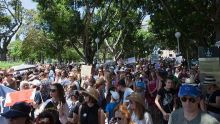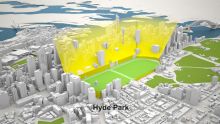Diagnosing Sydney's entrenched health inequities was not something the Committee of Sydney had intended to do.
They were getting ready to release an economic paper.
More NSW News Videos
An integrative approach to tackling diabetes
Mt Druitt Medical Centre is leading the way with an integrative approach to diabetes treatment and the results are proving positive.
"We had no intention of compiling a health report," said Committee of Sydney's director of policy Eamon Waterford.
"But it became clear that the way we build our city is not only dividing us, it's making us ill," he said.
Their findings released Saturday prompted a controversial push from the report's authors for more high density housing, compact city living, more walkable town centres, expanding the rail network and introducing a cycle-to-work program.
People who live in western Sydney are twice as likely to die from cardiovascular diseases like heart failure and stroke, data from HealthStats NSW shows.
An estimated 300,000 of the 1 million people living in western Sydney have diabetes or pre-diabetes and more than half the residents in Auburn, Blacktown, Holroyd, Parramatta and the Hills District are overweight.
If you were to overlay a geographical map showing the rates of diabetes, obesity and cardiovascular diseases across Sydney with a map of Sydney's distribution of low density areas and poor public transport access, they'd come close to overlapping neatly, according to the Committee of Sydney report.

The key difference was the lack of walkability and access to public transport in west Sydney compared to the CBD, and the reliance on cars to get to work and essential services, the report said.
"There is a deeply entrenched divide across the city along health, economic, social and education lines," said Committee of Sydney acting chief executive Eamon Waterford.
The analysis drew on job density data across Sydney; how easily it is for people to get to their workplaces, as well as effective service density; how easily people can get to essential services: train stations, shops, the GP, a laundromat.
"If you live in the inner city it's an easy walk to all of these places. You're getting a bunch of exercise purely by running errands – picking up your dry cleaning or groceries on the walk home after work."
But if you live in west Sydney's urban sprawl, you're far more likely to jump in the car to reach these sorts of services several minutes' drive away.
"People totally discount incidental exercise. They don't think it's vital to health, but it can make a big difference."
In Charlotte, US researchers found people who regularly walked a short distance to a light rail stop lost five kilograms on average in one year. Conversely, those who drove an hour a day had a 6 per cent higher risk of obesity.
That inequity had far-reaching consequences for productivity.
"International evidence clearly shows that cities that have a focus on walkability and good access to public transport deliver better economic outcomes for the city and its citizens," Mr Waterford said.
Sydney cannot continue to deliver economically unless west Sydney has access to the benefits that eastern Sydney already enjoys, the committee argued.
"We need an effective strategy that targets the divide if we want our city to perform its vital role in the Australian economy," Mr Waterford said.
Governments needed to rejuvenate the old town centres dotted across Sydney's west: the second-tiered cities like Blacktown and Mount Druitt that have seen their economies gone backwards as more jobs move to bigger centres like Parramatta and the CBD.
"We need to put local services and local jobs back into these communities and provide people with a reason to walk to work, to to walk to the shops," Mr Waterford said.
The committee also urged the state government to introduce an expanded rail network in west Sydney, a light rail in Parramatta and a cycle-to-work scheme based on the UK government's tax exemption measure that encourages employers to loan cycles and safety equipment to employees.
"At the same time we need to have a serious conversation about density," Mr Waterford said.
It was completely understandable that people were skeptical about density. "Truth be told we've all seen a lot of examples in Australia, and in Sydney where it hasn't been done well."
People were often critical of high density because they would see an influx of people move into their neighbourhoods accompanied by no improvements in services and amenities to cater for population growth.
"You can't build effective public transport systems without density. You're not going to build a train station in an area if there aren't enough people to use it.
"[Introducing] more people and more amenities at the same time is density done well. It unlocks more public transport, more shops, more jobs, hospitals, and green space," he said.
A spokesperson for the Greater Sydney Commission said it was focused on delivering more walkable communities.
The commission's draft of the Towards Our Greater Sydney 2056 report released in November earmarked planning for an equitable "polycentric centre" where people were within 30 minutes of jobs and services was a major priority.
"The Commission will be working with across local and state government, the private sector and local communities to ensure that new developments support better health outcomes for people, particularly in Western Sydney," the spokesperson said in a statement.

















